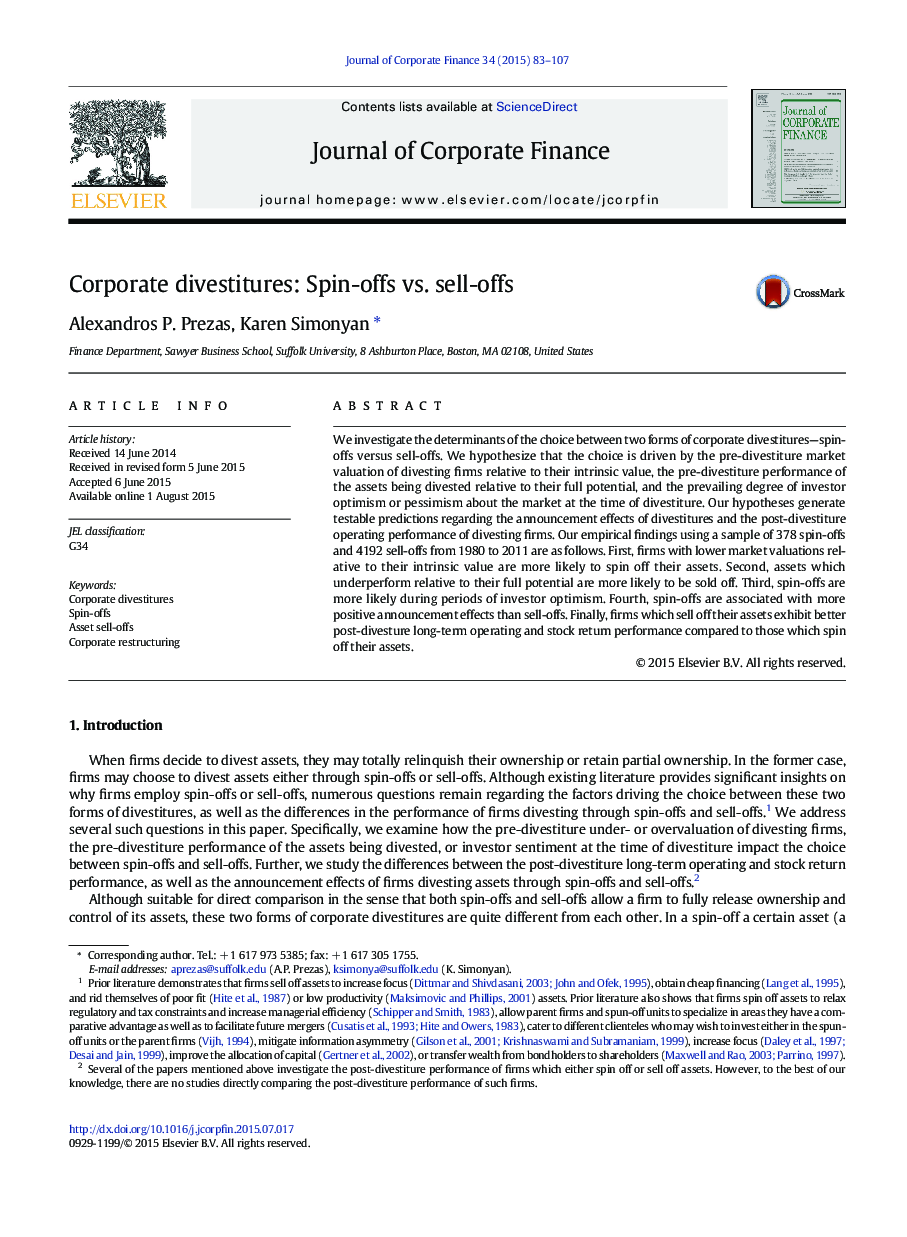| کد مقاله | کد نشریه | سال انتشار | مقاله انگلیسی | نسخه تمام متن |
|---|---|---|---|---|
| 5093401 | 1478442 | 2015 | 25 صفحه PDF | دانلود رایگان |
عنوان انگلیسی مقاله ISI
Corporate divestitures: Spin-offs vs. sell-offs
ترجمه فارسی عنوان
تسویه حساب های شرکت: اسپین آف در مقابل فروش سهام
دانلود مقاله + سفارش ترجمه
دانلود مقاله ISI انگلیسی
رایگان برای ایرانیان
ترجمه چکیده
ما عوامل موثر بر انتخاب بین دو نوع تقسیم شرکت ها - اسپین آف ها و فروش ها را بررسی می کنیم. ما فرض می کنیم که انتخاب به وسیله ارزیابی بازار قبل از فروش به شرکت های واگذار شده نسبت به ارزش ذاتی آنها، عملکرد پیش فروش دارایی ها نسبت به پتانسیل کامل آنها، و درجه غالب خوش بینی یا نگرانی سرمایه گذاران در مورد بازار در زمان واگذاری. فرضیه های ما پیش بینی های قابل آزمون را در رابطه با اثرات اعلام شده از فروش و عملکرد عملیاتی بعد از فروش شرکت های واگذار شده تولید می کنند. یافته های تجربی ما با استفاده از نمونه ای از 378 اسپین آف و 4192 فروش در سال های 1980 تا 2011 به شرح زیر است. اولا، شرکت هایی که ارزیابی های بازار پایین تر نسبت به ارزش ذاتی خود دارند، بیشتر احتمال دارد که از دارایی های خود جدا شوند. دوم، دارایی هایی که نسبت به پتانسیل کاملشان نسبت به عملکرد پایین تر عمل می کنند، بیشتر احتمال دارد که فروخته شوند. سوم، اسپین آف در دوره های خوش بینی سرمایه گذاران بیشتر است. چهارم، اسپین آف با اثرات مثبت اعلام شده بیشتر از فروش است. سرانجام، بنگاه هایی که دارایی های خود را به فروش می رسانند، بازده عملکرد بازده سهام و بازده سهام را در مقایسه با دارایی های خود تغییر می دهند.
موضوعات مرتبط
علوم انسانی و اجتماعی
مدیریت، کسب و کار و حسابداری
کسب و کار و مدیریت بین المللی
چکیده انگلیسی
We investigate the determinants of the choice between two forms of corporate divestitures-spin-offs versus sell-offs. We hypothesize that the choice is driven by the pre-divestiture market valuation of divesting firms relative to their intrinsic value, the pre-divestiture performance of the assets being divested relative to their full potential, and the prevailing degree of investor optimism or pessimism about the market at the time of divestiture. Our hypotheses generate testable predictions regarding the announcement effects of divestitures and the post-divestiture operating performance of divesting firms. Our empirical findings using a sample of 378 spin-offs and 4192 sell-offs from 1980 to 2011 are as follows. First, firms with lower market valuations relative to their intrinsic value are more likely to spin off their assets. Second, assets which underperform relative to their full potential are more likely to be sold off. Third, spin-offs are more likely during periods of investor optimism. Fourth, spin-offs are associated with more positive announcement effects than sell-offs. Finally, firms which sell off their assets exhibit better post-divesture long-term operating and stock return performance compared to those which spin off their assets.
ناشر
Database: Elsevier - ScienceDirect (ساینس دایرکت)
Journal: Journal of Corporate Finance - Volume 34, October 2015, Pages 83-107
Journal: Journal of Corporate Finance - Volume 34, October 2015, Pages 83-107
نویسندگان
Alexandros P. Prezas, Karen Simonyan,
